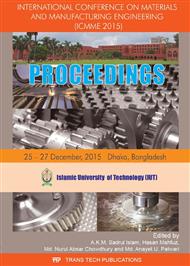[1]
E.I. Sherif, G. Deierlein, Strength and Ductility of Concrete Encased Composite Columns, Journal of structural Engineering, vol125(9), pp.1009-1019, (1999).
DOI: 10.1061/(asce)0733-9445(1999)125:9(1009)
Google Scholar
[2]
S.A. Mirza, B.W. Skrabek, Statistical analysis of slender composite beam–column Strength, Journal of Structural Engineering, ASCE; vol118(5): 1312–31, (1992).
DOI: 10.1061/(asce)0733-9445(1992)118:5(1312)
Google Scholar
[3]
K.S. Virdi, P.J. Dowling, The ultimate strength of composite columns in biaxial bending, Proceedings of the institution of civil engineers, Part 2, 251-272, (1973).
DOI: 10.1680/iicep.1973.4958
Google Scholar
[4]
P.R. Munoz C.T.T. Hsu, Behavior of Biaxial Loaded Concrete- Encased Composite Columns". Journal of structural Engineering, vol 123, No. 9pp 1163-1171, (1997).
DOI: 10.1061/(asce)0733-9445(1997)123:9(1163)
Google Scholar
[5]
N.E. Shanmugam, B. Lakshmi, State of art report on steel composite columns, Journal of constructional steel research, vol l57, pp.1041-80, ( 2001).
DOI: 10.1016/s0143-974x(01)00021-9
Google Scholar
[6]
M. M. EL-Attar, H. Z. El-Karmoty, A. A. EL-Moneim, The behavior of ultra-high-strength reinforced concrete columns under axial and cyclic lateral loads, Journal Housing and Building National Research Center, Cairo, Egypt, (2015).
DOI: 10.1016/j.hbrcj.2014.10.003
Google Scholar
[7]
C. Campian, Z. Nagy, M. Pop, Behavior of fully encased steel-concrete composite columns subjected to monotonic and cyclic loading, International Scientific Conference Urban Civil Engineering and Municipal Facilities, SPbUCEMF-2015Procedia Engineering 117 p.439.
DOI: 10.1016/j.proeng.2015.08.193
Google Scholar
[8]
S. Tokgoz, C. Dundar, Experimental tests on biaxial loaded concrete encased composite columns, Journal on Steel and Composite Structure, vol8(5), pp.423-438, (2008).
DOI: 10.12989/scs.2008.8.5.423
Google Scholar
[9]
C.C. Chen, N.J. Lin, Analytical model for predicting axial capacity and behavior of concrete encased steel composite stub columns, Journal of Constructional Steel Research, vol62 , p.424–433, (2006).
DOI: 10.1016/j.jcsr.2005.04.021
Google Scholar
[10]
C.S. Kim, H.G. Park, K.S. Chung, I.R. Choi, Eccentric Axial Load Testing for Concrete-Encased Steel Columns Using 800 MPa Steel and 100 MPa Concrete, Journal of Structural Engineering, ASCE; vol. 138(8): pp.1019-1031, (2012).
DOI: 10.1061/(asce)st.1943-541x.0000533
Google Scholar
[11]
E. Ellobodya, B. Young, Numerical simulation of concrete encased steel composite columns, Journal of Constructional Steel Research, vol67, p.211–222, (2011).
DOI: 10.1016/j.jcsr.2010.08.003
Google Scholar
[12]
BNBC, Bangladesh National Building Code, Housing and Building Research Institute, Dhaka, Bangladesh, (1993).
Google Scholar
[13]
Hibbitt, Karlsson and Sorensen, Inc (HKS). ABAQUS/Explicit User's Manual, Version 6. 10, (2010).
Google Scholar
[14]
D.J. Carreira, K.H. Chu, Stress-Strain relationship for plain concrete in compression, ACI Journal, Technical Paper, 82-72, (1984).
Google Scholar
[15]
D.J. Carreira, K.H. Chu, Stress-Strain relationship for Reinforced concrete in Tension, ACI Journal, Technical Paper, 83-3, (1984).
Google Scholar
[16]
K.Z. Soliman A.I. Arafa T.M. EIrakib, Review of Design Codes of Concrete encased steel short columns under axial compression, Journal House and Building National Research center, Cairo, EgyptVol9, 134-143 (2013).
DOI: 10.1016/j.hbrcj.2013.02.002
Google Scholar


